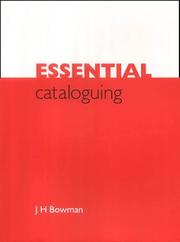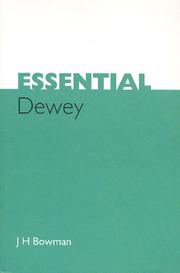| Listing 1 - 6 of 6 |
Sort by
|

ISBN: 1856044564 1306366542 1856049779 9781856049771 9781856044561 Year: 2003 Publisher: London Facet
Abstract | Keywords | Export | Availability | Bookmark
 Loading...
Loading...Choose an application
- Reference Manager
- EndNote
- RefWorks (Direct export to RefWorks)
Mystified by main entry? Confused by corporate bodies? Can't tell a description from an access point? Then this is the book for you. Cataloguing is important, despite what some people may tell you. Because it is hardly taught nowadays, there is all the more likelihood that you will find yourself having to catalogue without having been taught anything about it. This book covers descriptive cataloguing, and is designed as a simple companion to the Anglo-American Cataloguing Rules (revised 2002 edition). Dealing primarily with printed books, but including many references to other formats, the author leads you step by step through the cataloguing process, covering: description; access points; multipart works; headings for persons; headings for corporate bodies; authority control and uniform titles.
#A0403A --- Cataloguing --- Descriptive cataloging --- MARC formats --- 025.3 --- 025.32 --- 611 Bibliotheken --- 025.3 Catalogustechniek. Catalogiseren --- Catalogustechniek. Catalogiseren --- APIN (Information retrieval system) --- CATS System --- Formats, MARC --- Machine-Readable Cataloging formats --- MARC System --- Machine-readable bibliographic data formats --- Cataloging --- Format --- Anglo-American cataloguing rules --- AACR 2 --- Anglo-American cataloging rules --- AACR2 --- Alphabetical cataloguing --- Description bibliographique --- Handbooks, manuals, etc. --- Guides, manuels, etc
Book
ISBN: 0773429948 9780773429949 9780773436343 0773436340 Year: 2010 Publisher: Lewiston Edwin Mellen Press
Abstract | Keywords | Export | Availability | Bookmark
 Loading...
Loading...Choose an application
- Reference Manager
- EndNote
- RefWorks (Direct export to RefWorks)
Robert Proctor will always be remembered among bibliographers for two things: for his rearrange¬ment of the incunabula in the British Museum in what has become known as 'Proctor order', based on the way in which printing spread in its early days; and for the mystery which continues to surround his death. Born in 1868, he was appointed to the British Museum in 1891, and in 1898 he published his Index to the Early Printed Books in the British Museum. In 1899 he started to keep a private diary, and this lasted until his death in 1903. One of the volumes is missing, but the remaining three are edited and published for the first time here.
Bibliographers -- England -- Diaries. --- British Museum -- Officials and employees -- Diaries. --- Incunabula -- Bibliography -- Methodology. --- Librarians -- England -- Diaries. --- Proctor, Robert, b. 1868 -- Diaries. --- Bibliographers --- Librarians --- Incunabula --- General --- Bibliography - General --- Early printed books --- Cradle books (Early printed books) --- Incunables --- Books --- Information scientists --- Library employees --- Libraries --- Methodology --- Bibliography --- 09 <092 PROCTOR, ROBERT> --- 09 <092 PROCTOR, ROBERT> Handschriften. Oude en merkwaardige drukken. Curiosa--Biografieën--PROCTOR, ROBERT --- Handschriften. Oude en merkwaardige drukken. Curiosa--Biografieën--PROCTOR, ROBERT --- Bibliography&delete& --- Handschriften. Oude en merkwaardige drukken. Curiosa--Biografieën--PROCTOR, ROBERT --- Proctor, Robert, --- British Museum --- Daiei Hakubutsukan --- Matḥaf al-Barīṭānī --- Museo Británico --- Britské muzeum v Londýně --- Briṭish Muzeʼon --- Ta Ying po wu kuan --- Da Ying bo wu guan --- Museum Britannicum --- Great Britain. --- בריטיש מוזיאום --- מוזיאון הבריטי --- 大英博物館 --- British Library --- Officials and employees --- Proctor, Robert George Collier, --- Proctor, R.

ISBN: 1856049795 9781856049795 1856045196 9781856045193 1555705448 9781555705442 1306342236 Year: 2005 Publisher: London : Facet,
Abstract | Keywords | Export | Availability | Bookmark
 Loading...
Loading...Choose an application
- Reference Manager
- EndNote
- RefWorks (Direct export to RefWorks)
In this book, John Bowman provides an introduction to the Dewey Decimal Classification suitable either for beginners or for librarians who are out of practice using Dewey. He outlines the content and structure of the scheme and then, through worked examples using real titles, shows readers how to use it. Most chapters include practice exercises, to which answers are given at the end of the book. A particular feature of the book is the chapter dealing with problems of specific parts of the scheme. Later chapters offer advice on how to cope with compound subjects, and a brief introduction to the Web version of Dewey. Written in an engaging and direct style, this text is a companion volume both to the author's own bestselling Essential Cataloguing and to Vanda Broughton's Essential Classification. It is ideal for library students, and for public, school and solo librarians and classifiers who are just beginning to use Dewey and need some simple examples.

ISBN: 1856049779 9781856049771 1856044564 9781856044561 Year: 2003 Publisher: London
Abstract | Keywords | Export | Availability | Bookmark
 Loading...
Loading...Choose an application
- Reference Manager
- EndNote
- RefWorks (Direct export to RefWorks)
Mystified by main entry? Confused by corporate bodies? Can't tell a description from an access point? Then this is the book for you. Cataloguing is important, despite what some people may tell you. Because it is hardly taught nowadays, there is all the more likelihood that you will find yourself having to catalogue without having been taught anything about it. This book covers descriptive cataloguing, and is designed as a simple companion to the Anglo-American Cataloguing Rules (revised 2002 edition). Dealing primarily with printed books, but including many references to other formats, the author leads you step by step through the cataloguing process, covering: description; access points; multipart works; headings for persons; headings for corporate bodies; authority control and uniform titles.
Descriptive cataloging --- MARC formats --- APIN (Information retrieval system) --- CATS System --- Formats, MARC --- Machine-Readable Cataloging formats --- MARC System --- Machine-readable bibliographic data formats --- Cataloging --- Format --- Anglo-American cataloguing rules --- AACR 2 --- Anglo-American cataloging rules --- AACR2

ISBN: 9780754647799 9780754647782 Year: 2006 Publisher: Aldershot ; Burlington Ashgate
Abstract | Keywords | Export | Availability | Bookmark
 Loading...
Loading...Choose an application
- Reference Manager
- EndNote
- RefWorks (Direct export to RefWorks)

ISBN: 9781856049795 1856049795 1856045196 9781856045193 1555705448 9781555705442 Year: 2005 Publisher: London Facet
Abstract | Keywords | Export | Availability | Bookmark
 Loading...
Loading...Choose an application
- Reference Manager
- EndNote
- RefWorks (Direct export to RefWorks)
| Listing 1 - 6 of 6 |
Sort by
|

 Search
Search Feedback
Feedback About UniCat
About UniCat  Help
Help News
News